2016 NISSAN SENTRA phone
[x] Cancel search: phonePage 286 of 478
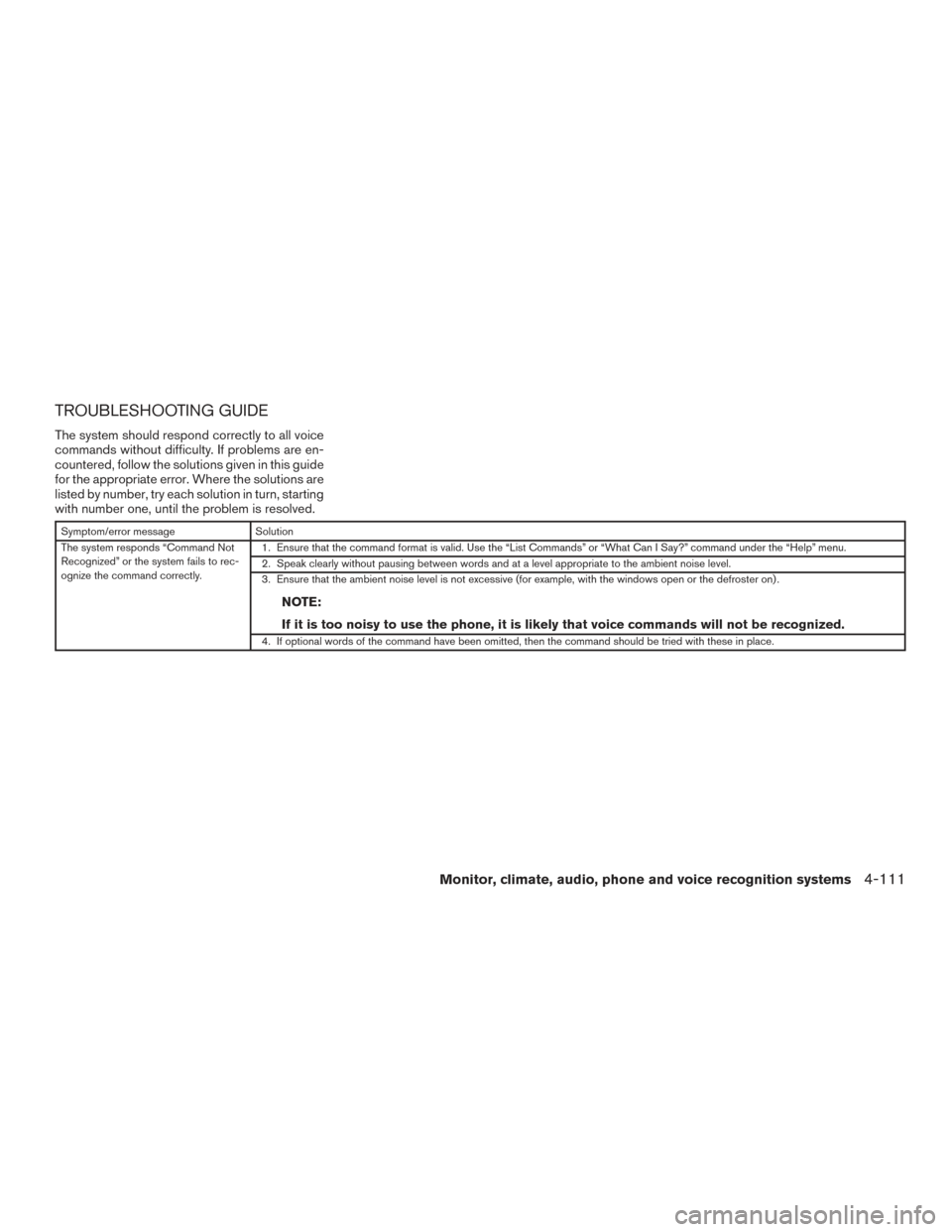
TROUBLESHOOTING GUIDE
The system should respond correctly to all voice
commands without difficulty. If problems are en-
countered, follow the solutions given in this guide
for the appropriate error. Where the solutions are
listed by number, try each solution in turn, starting
with number one, until the problem is resolved.
Symptom/error messageSolution
The system responds “Command Not
Recognized” or the system fails to rec-
ognize the command correctly. 1. Ensure that the command format is valid. Use the “List Commands” or “What Can I Say?” command under the “Help” menu.
2. Speak clearly without pausing between words and at a level appropriate to the ambient noise level.
3. Ensure that the ambient noise level is not excessive (for example, with the windows open or the defroster on) .
NOTE:
If it is too noisy to use the phone, it is likely that voice commands will not be recognized.
4. If optional words of the command have been omitted, then the command should be tried with these in place.
Monitor, climate, audio, phone and voice recognition systems4-111
Page 301 of 478
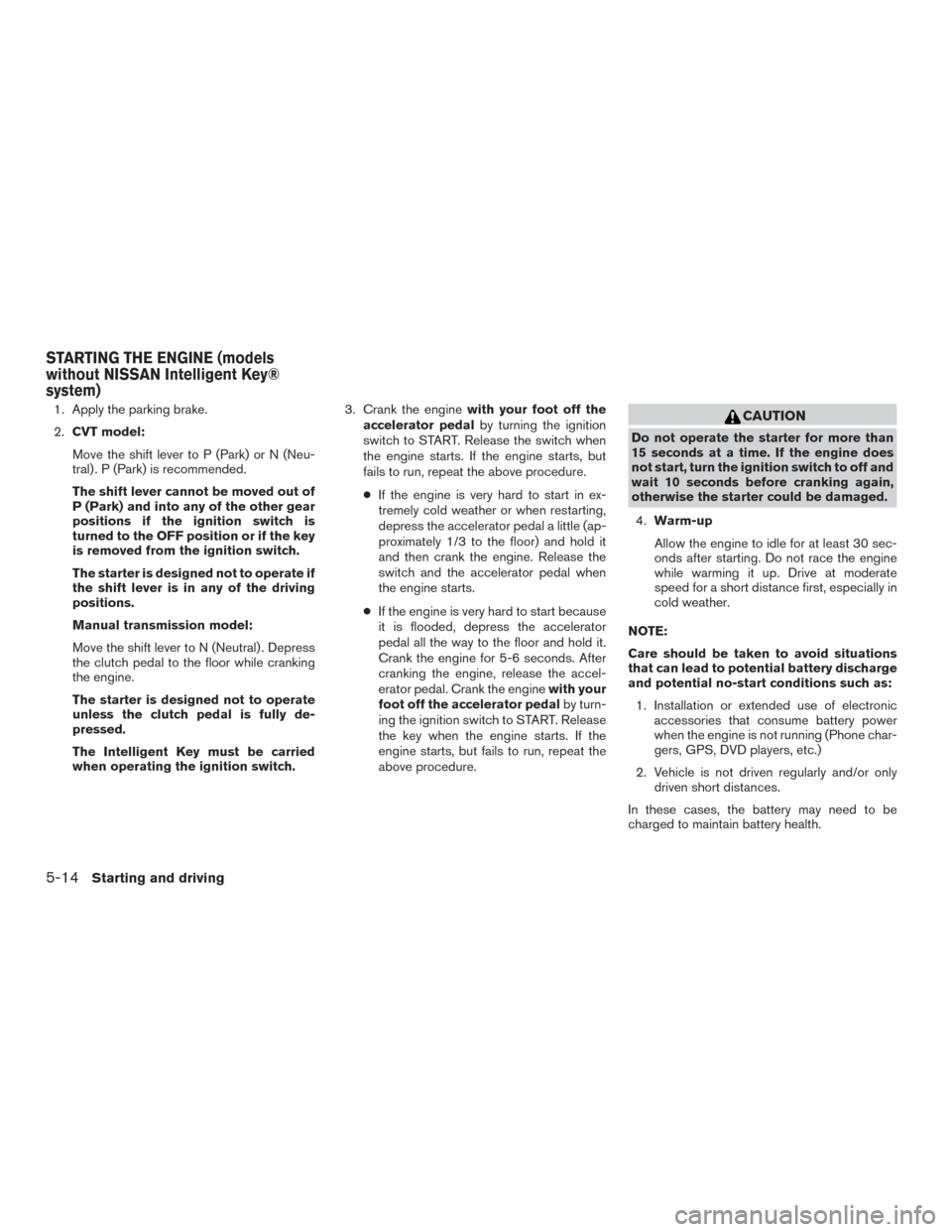
1. Apply the parking brake.
2.CVT model:
Move the shift lever to P (Park) or N (Neu-
tral) . P (Park) is recommended.
The shift lever cannot be moved out of
P (Park) and into any of the other gear
positions if the ignition switch is
turned to the OFF position or if the key
is removed from the ignition switch.
The starter is designed not to operate if
the shift lever is in any of the driving
positions.
Manual transmission model:
Move the shift lever to N (Neutral) . Depress
the clutch pedal to the floor while cranking
the engine.
The starter is designed not to operate
unless the clutch pedal is fully de-
pressed.
The Intelligent Key must be carried
when operating the ignition switch. 3. Crank the engine
with your foot off the
accelerator pedal by turning the ignition
switch to START. Release the switch when
the engine starts. If the engine starts, but
fails to run, repeat the above procedure.
● If the engine is very hard to start in ex-
tremely cold weather or when restarting,
depress the accelerator pedal a little (ap-
proximately 1/3 to the floor) and hold it
and then crank the engine. Release the
switch and the accelerator pedal when
the engine starts.
● If the engine is very hard to start because
it is flooded, depress the accelerator
pedal all the way to the floor and hold it.
Crank the engine for 5-6 seconds. After
cranking the engine, release the accel-
erator pedal. Crank the engine with your
foot off the accelerator pedal by turn-
ing the ignition switch to START. Release
the key when the engine starts. If the
engine starts, but fails to run, repeat the
above procedure.CAUTION
Do not operate the starter for more than
15 seconds at a time. If the engine does
not start, turn the ignition switch to off and
wait 10 seconds before cranking again,
otherwise the starter could be damaged.
4. Warm-up
Allow the engine to idle for at least 30 sec-
onds after starting. Do not race the engine
while warming it up. Drive at moderate
speed for a short distance first, especially in
cold weather.
NOTE:
Care should be taken to avoid situations
that can lead to potential battery discharge
and potential no-start conditions such as: 1. Installation or extended use of electronic accessories that consume battery power
when the engine is not running (Phone char-
gers, GPS, DVD players, etc.)
2. Vehicle is not driven regularly and/or only driven short distances.
In these cases, the battery may need to be
charged to maintain battery health.
STARTING THE ENGINE (models
without NISSAN Intelligent Key®
system)
5-14Starting and driving
Page 302 of 478
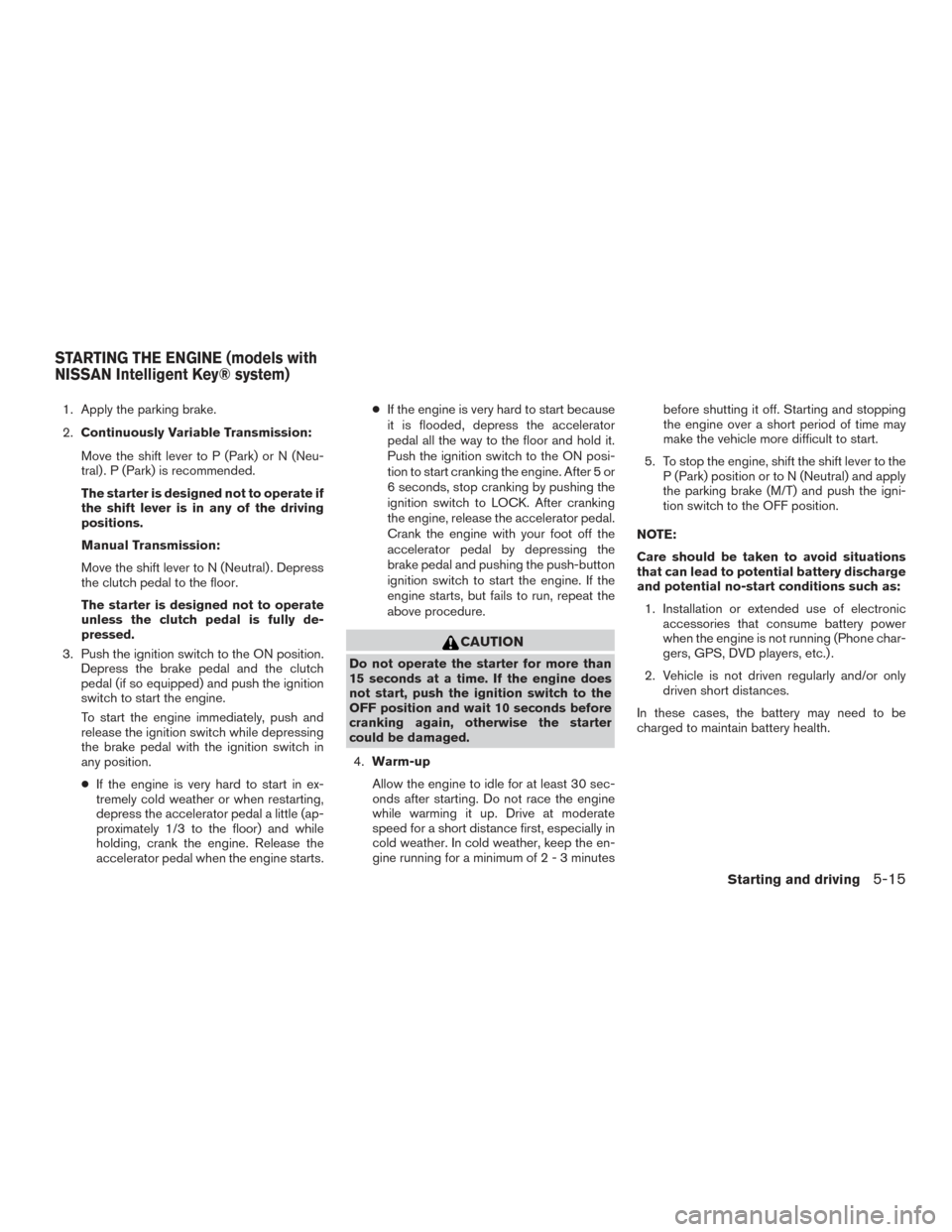
1. Apply the parking brake.
2.Continuously Variable Transmission:
Move the shift lever to P (Park) or N (Neu-
tral) . P (Park) is recommended.
The starter is designed not to operate if
the shift lever is in any of the driving
positions.
Manual Transmission:
Move the shift lever to N (Neutral) . Depress
the clutch pedal to the floor.
The starter is designed not to operate
unless the clutch pedal is fully de-
pressed.
3. Push the ignition switch to the ON position. Depress the brake pedal and the clutch
pedal (if so equipped) and push the ignition
switch to start the engine.
To start the engine immediately, push and
release the ignition switch while depressing
the brake pedal with the ignition switch in
any position.
● If the engine is very hard to start in ex-
tremely cold weather or when restarting,
depress the accelerator pedal a little (ap-
proximately 1/3 to the floor) and while
holding, crank the engine. Release the
accelerator pedal when the engine starts. ●
If the engine is very hard to start because
it is flooded, depress the accelerator
pedal all the way to the floor and hold it.
Push the ignition switch to the ON posi-
tion to start cranking the engine. After 5 or
6 seconds, stop cranking by pushing the
ignition switch to LOCK. After cranking
the engine, release the accelerator pedal.
Crank the engine with your foot off the
accelerator pedal by depressing the
brake pedal and pushing the push-button
ignition switch to start the engine. If the
engine starts, but fails to run, repeat the
above procedure.
CAUTION
Do not operate the starter for more than
15 seconds at a time. If the engine does
not start, push the ignition switch to the
OFF position and wait 10 seconds before
cranking again, otherwise the starter
could be damaged.
4. Warm-up
Allow the engine to idle for at least 30 sec-
onds after starting. Do not race the engine
while warming it up. Drive at moderate
speed for a short distance first, especially in
cold weather. In cold weather, keep the en-
gine running for a minimum of2-3minutes before shutting it off. Starting and stopping
the engine over a short period of time may
make the vehicle more difficult to start.
5. To stop the engine, shift the shift lever to the P (Park) position or to N (Neutral) and apply
the parking brake (M/T) and push the igni-
tion switch to the OFF position.
NOTE:
Care should be taken to avoid situations
that can lead to potential battery discharge
and potential no-start conditions such as: 1. Installation or extended use of electronic accessories that consume battery power
when the engine is not running (Phone char-
gers, GPS, DVD players, etc.) .
2. Vehicle is not driven regularly and/or only driven short distances.
In these cases, the battery may need to be
charged to maintain battery health.
STARTING THE ENGINE (models with
NISSAN Intelligent Key® system)
Starting and driving5-15
Page 391 of 478
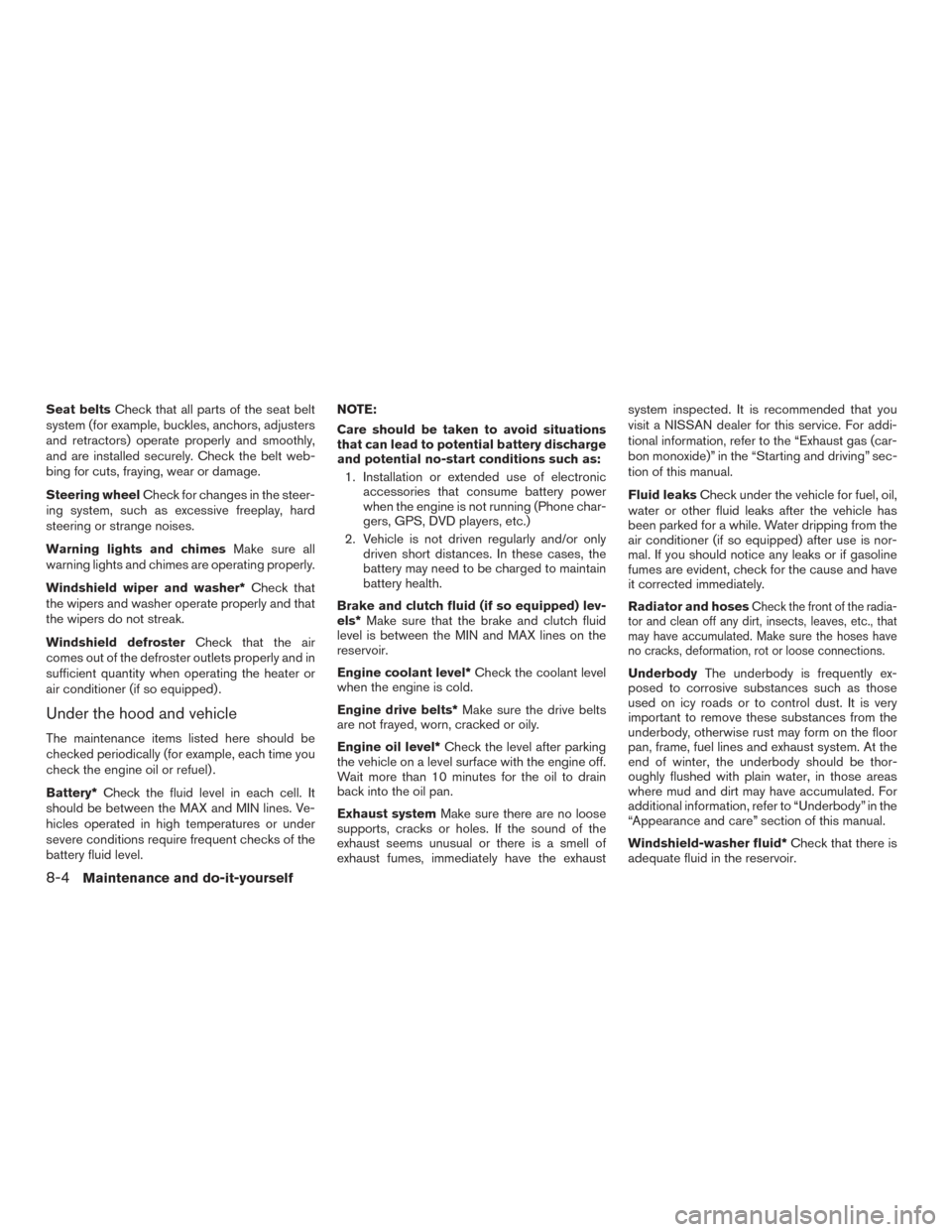
Seat beltsCheck that all parts of the seat belt
system (for example, buckles, anchors, adjusters
and retractors) operate properly and smoothly,
and are installed securely. Check the belt web-
bing for cuts, fraying, wear or damage.
Steering wheel Check for changes in the steer-
ing system, such as excessive freeplay, hard
steering or strange noises.
Warning lights and chimes Make sure all
warning lights and chimes are operating properly.
Windshield wiper and washer* Check that
the wipers and washer operate properly and that
the wipers do not streak.
Windshield defroster Check that the air
comes out of the defroster outlets properly and in
sufficient quantity when operating the heater or
air conditioner (if so equipped) .
Under the hood and vehicle
The maintenance items listed here should be
checked periodically (for example, each time you
check the engine oil or refuel) .
Battery* Check the fluid level in each cell. It
should be between the MAX and MIN lines. Ve-
hicles operated in high temperatures or under
severe conditions require frequent checks of the
battery fluid level. NOTE:
Care should be taken to avoid situations
that can lead to potential battery discharge
and potential no-start conditions such as:
1. Installation or extended use of electronic accessories that consume battery power
when the engine is not running (Phone char-
gers, GPS, DVD players, etc.)
2. Vehicle is not driven regularly and/or only driven short distances. In these cases, the
battery may need to be charged to maintain
battery health.
Brake and clutch fluid (if so equipped) lev-
els* Make sure that the brake and clutch fluid
level is between the MIN and MAX lines on the
reservoir.
Engine coolant level* Check the coolant level
when the engine is cold.
Engine drive belts* Make sure the drive belts
are not frayed, worn, cracked or oily.
Engine oil level* Check the level after parking
the vehicle on a level surface with the engine off.
Wait more than 10 minutes for the oil to drain
back into the oil pan.
Exhaust system Make sure there are no loose
supports, cracks or holes. If the sound of the
exhaust seems unusual or there is a smell of
exhaust fumes, immediately have the exhaust system inspected. It is recommended that you
visit a NISSAN dealer for this service. For addi-
tional information, refer to the “Exhaust gas (car-
bon monoxide)” in the “Starting and driving” sec-
tion of this manual.
Fluid leaks
Check under the vehicle for fuel, oil,
water or other fluid leaks after the vehicle has
been parked for a while. Water dripping from the
air conditioner (if so equipped) after use is nor-
mal. If you should notice any leaks or if gasoline
fumes are evident, check for the cause and have
it corrected immediately.
Radiator and hoses
Check the front of the radia-
tor and clean off any dirt, insects, leaves, etc., that
may have accumulated. Make sure the hoses have
no cracks, deformation, rot or loose connections.
Underbody The underbody is frequently ex-
posed to corrosive substances such as those
used on icy roads or to control dust. It is very
important to remove these substances from the
underbody, otherwise rust may form on the floor
pan, frame, fuel lines and exhaust system. At the
end of winter, the underbody should be thor-
oughly flushed with plain water, in those areas
where mud and dirt may have accumulated. For
additional information, refer to “Underbody” in the
“Appearance and care” section of this manual.
Windshield-washer fluid* Check that there is
adequate fluid in the reservoir.
8-4Maintenance and do-it-yourself
Page 401 of 478
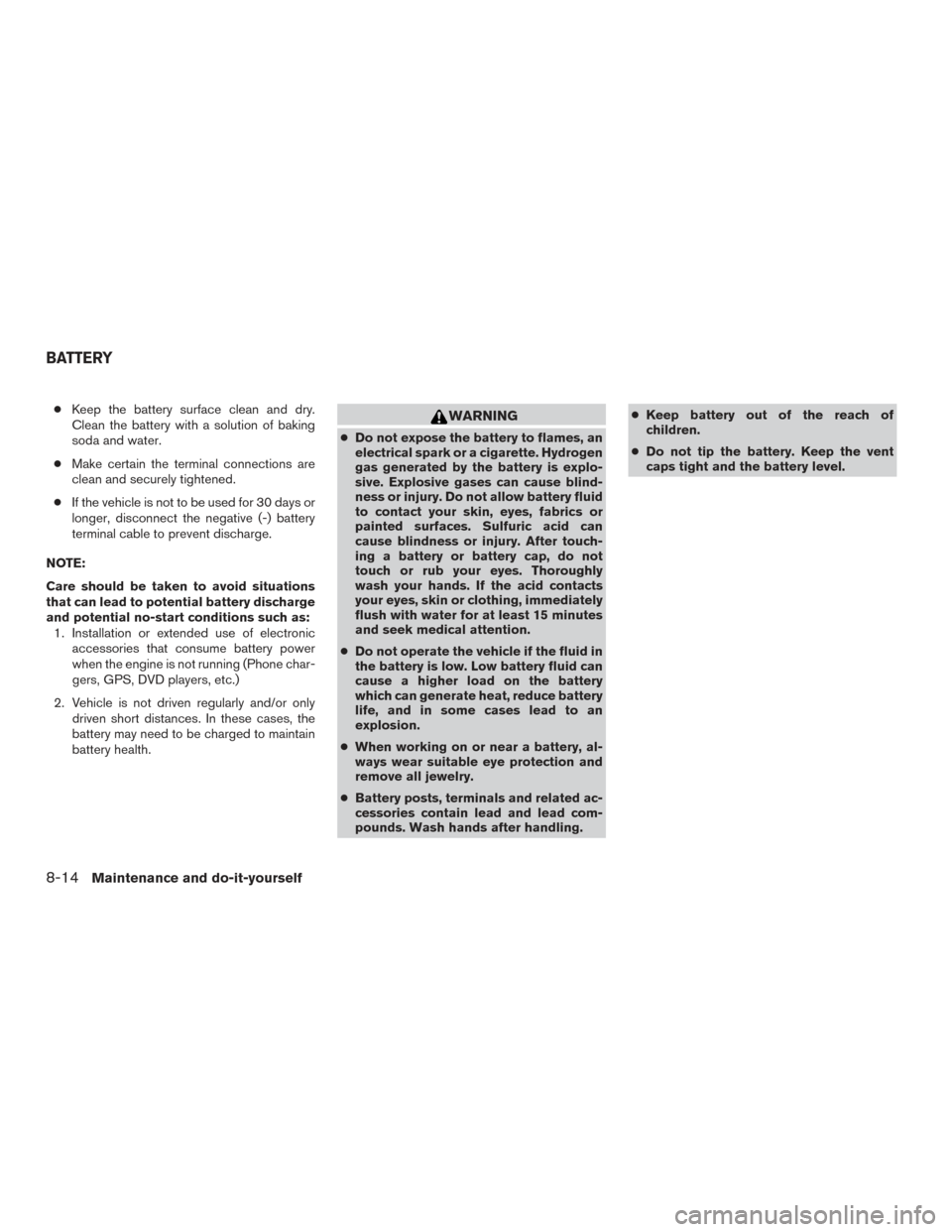
●Keep the battery surface clean and dry.
Clean the battery with a solution of baking
soda and water.
● Make certain the terminal connections are
clean and securely tightened.
● If the vehicle is not to be used for 30 days or
longer, disconnect the negative (-) battery
terminal cable to prevent discharge.
NOTE:
Care should be taken to avoid situations
that can lead to potential battery discharge
and potential no-start conditions such as: 1. Installation or extended use of electronic accessories that consume battery power
when the engine is not running (Phone char-
gers, GPS, DVD players, etc.)
2. Vehicle is not driven regularly and/or only driven short distances. In these cases, the
battery may need to be charged to maintain
battery health.WARNING
●Do not expose the battery to flames, an
electrical spark or a cigarette. Hydrogen
gas generated by the battery is explo-
sive. Explosive gases can cause blind-
ness or injury. Do not allow battery fluid
to contact your skin, eyes, fabrics or
painted surfaces. Sulfuric acid can
cause blindness or injury. After touch-
ing a battery or battery cap, do not
touch or rub your eyes. Thoroughly
wash your hands. If the acid contacts
your eyes, skin or clothing, immediately
flush with water for at least 15 minutes
and seek medical attention.
● Do not operate the vehicle if the fluid in
the battery is low. Low battery fluid can
cause a higher load on the battery
which can generate heat, reduce battery
life, and in some cases lead to an
explosion.
● When working on or near a battery, al-
ways wear suitable eye protection and
remove all jewelry.
● Battery posts, terminals and related ac-
cessories contain lead and lead com-
pounds. Wash hands after handling. ●
Keep battery out of the reach of
children.
● Do not tip the battery. Keep the vent
caps tight and the battery level.
BATTERY
8-14Maintenance and do-it-yourself
Page 453 of 478

Genuine NISSAN Service Manuals for this model
year and prior can be purchased. A Genuine
NISSAN Service Manual is the best source of
service and repair information for your vehicle.
This manual is the same one used by the factory-
trained technicians working at NISSAN dealer-
ships. Genuine NISSAN Owner’s Manuals can
also be purchased.
For USA
For current pricing and availability of Genuine
NISSAN Service Manuals,contact:
www.nissan-techinfo.com
For current pricing and availability of Genuine
NISSAN Owner’s Manuals, contact:
1-800-247-5321
For Canada
To purchase a copy of a Genuine NISSAN Ser-
vice Manual or Owner’s Manual, for this model
year and prior, please visit the nearest NISSAN
dealer. For the phone number and location of a
NISSAN dealer in your area, call the NISSAN
Information Center at 1-800-387-0122 and a
bilingual NISSAN representative will assist you.
OWNER’S MANUAL/SERVICE
MANUAL ORDER INFORMATION
9-22Technical and consumer information
Page 454 of 478

10 Index
A
ABS (Anti-lock Braking System) ........5-71
Air bag (See supplemental restraint
system) .....................1-41
Air bag system Front (See supplemental front impact
air bag system) ...............1-48
Side and curtain (See supplemental
side air bag and curtain side-impact
air bag system) ...............1-56
Airbagwarninglabels.............1-58
Airbagwarninglight...........1-59,2-20
Air bag warning light, supplemental . .1-59, 2-20
Aircleaner....................8-18
Air cleaner housing filter ............8-18
Air conditioner Air conditioner operation ..........4-19
Air conditioner service ...........4-27
Air conditioner specification label .....9-13
Air conditioner system refrigerant and
oil recommendations .............9-7
Air conditioner system refrigerant
recommendations ..............9-7
Heater and air conditioner (automatic)
(if so equipped) ...............4-24
Heater and air conditioner
controls................4-18,4-25
Heater and air conditioner (manual) ....4-16
Servicing air conditioner ..........4-27
Airflowcharts..................4-20 Alarm system
(See vehicle security system)
.........2-35
Anchor point locations .............1-25
Antenna.....................4-64
Antifreeze ....................5-75
Anti-lock Braking System (ABS) ........5-71
Apps .......................4-65
APPS button ...................4-7
Armrests .....................1-6
Audible reminders ...............2-23
Audio system ..................4-27
AMradioreception.............4-28
Bluetooth®audio..............4-61
Bluetooth® streaming audio ........4-61
Compact disc (CD) player . .4-38, 4-43, 4-50
FM/AM radio with compact disc (CD)
player ....................4-35
FM/AM/SAT radio with compact disc
(CD) player ..............4-40,4-45
FMradioreception..........4-27,4-36
iPod® Player .............4-55,4-57
iPod® player operation .......4-55,4-57
Radio ....................4-27
Steering wheel audio control switch . . .4-63
USB interface ............4-51,4-53
USB (Universal Serial Bus) Connection
Port..................4-51,4-53
Autolight switch .................2-40
Automatic Automatic power window switch .....2-53
Automatic anti-glare inside mirror .......3-31
Automatic door locks ..............3-6
AUXjack.................4-36,4-51 B
Back button ....................4-7
Battery ..................5-75, 8-14
Charge warning light ............2-17
Battery replacement ..............8-25
Keyfob................8-25,8-25
NISSAN Intelligent Key® ..........8-27
Before starting the engine ...........5-13
Belt (See drive belt) ..............8-16
Blind Spot Warning (BSW) ..........5-23
Block heater Engine ....................5-76
Bluetooth® audio ................4-61
Bluetooth® Hands-Free Phone System with
Navigation System ...............4-98
Bluetooth® Hands-Free Phone System without
Navigation System ............4-70,4-86
Bluetooth® streaming audio with Navigation
System .....................4-61
Boosterseats..................1-38
Brake Anti-lock Braking System (ABS) ......5-71
Brake fluid ..................8-12
Brakelight(Seestoplight).........8-31
Brake system ................
5-71
Brakewarninglight.............2-16
Brakewearindicators........2-23,8-21
Parking brake operation ..........5-21
Self-adjusting brakes ............8-21
Brake and clutch fluid .............8-12
Brake assist ...................5-72
Page 455 of 478
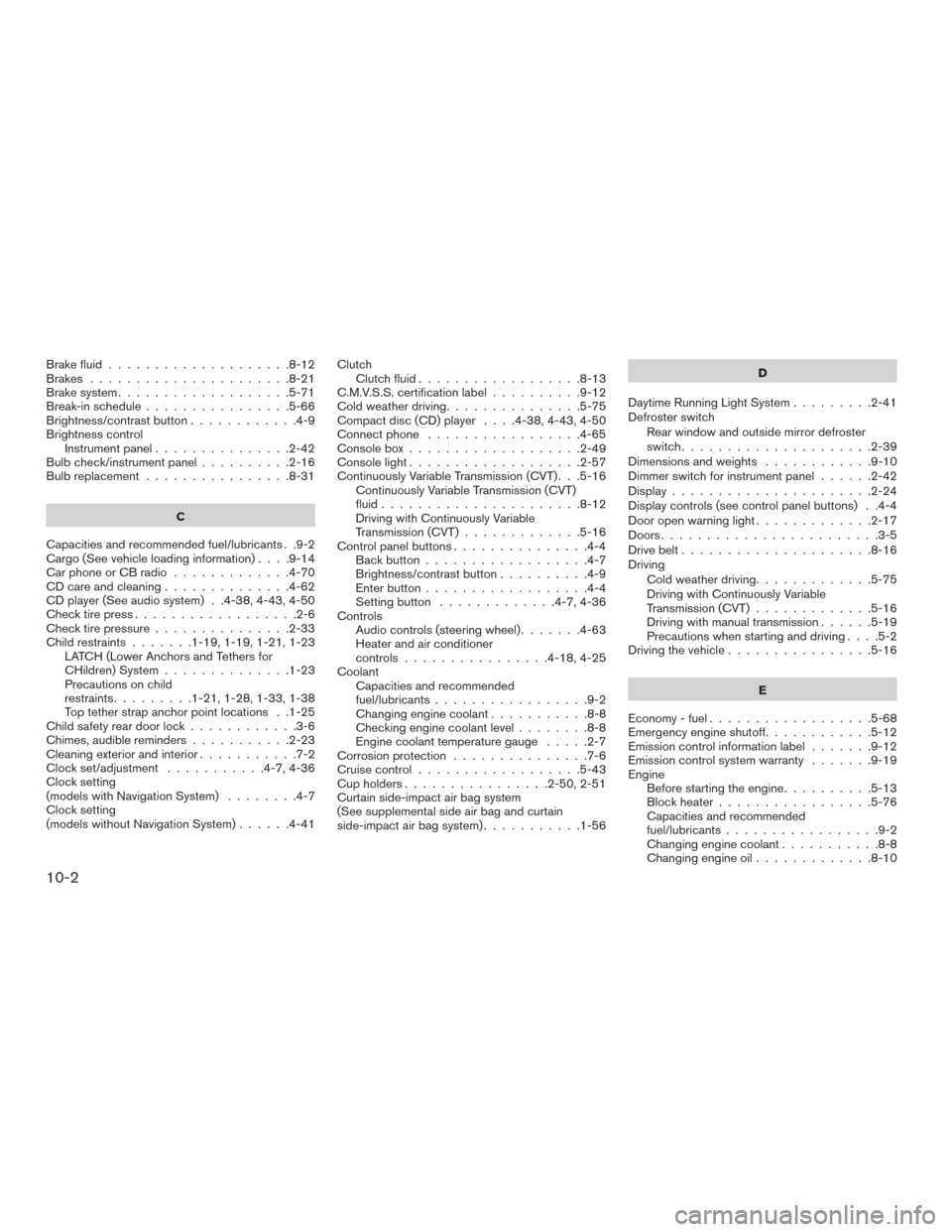
Brake fluid....................8-12
Brakes ......................8-21
Brake system ...................5-71
Break-in schedule ................5-66
Brightness/contrastbutton............4-9
Brightness control Instrument panel ...............2-42
Bulb check/instrument panel ..........2-16
Bulb replacement ................8-31
C
Capacities and recommended fuel/lubricants . .9-2
Cargo(Seevehicleloadinginformation)....9-14
Car phone or CB radio .............4-70
CD care and cleaning ..............4-62
CD player (See audio system) . .4-38, 4-43, 4-50
Check tire press ..................2-6
Check tire pressure ...............2-33
Child restraints .......1-19,1-19,1-21,1-23
LATCH (Lower Anchors and Tethers for
CHildren) System ..............1-23
Precautions on child
restraints.........1-21,1-28,1-33,1-38
Top tether strap anchor point locations . .1-25
Child safety rear door lock ............3-6
Chimes, audible reminders ...........2-23
Cleaningexteriorandinterior...........7-2
Clock set/adjustment ...........4-7,4-36
Clock setting
(models with Navigation System) ........4-7
Clock setting
(models without Navigation System) ......4-41Clutch
Clutch fluid ..................8-13
C.M.V.S.S. certification label ..........9-12
Cold weather driving ...............5-75
Compact disc (CD) player ....4-38,4-43,4-50
Connect phone .................4-65
Console box ...................2-49
Console light ...................2-57
Continuously Variable Transmission (CVT) . . .5-16 Continuously Variable Transmission (CVT)
fluid......................8-12
Driving with Continuously Variable
Transmission (CVT) .............5-16
Control panel buttons ...............4-4
Back button ..................4-7
Brightness/contrast button ..........4-9
Enterbutton..................4-4
Setting button .............4-7,4-36
Controls Audio controls (steering wheel) .......4-63
Heater and air conditioner
controls................4-18,4-25
Coolant Capacities and recommended
fuel/lubricants .................9-2
Changingenginecoolant...........8-8
Checking engine coolant level ........8-8
Engine coolant temperature gauge .....2-7
Corrosion protection ...............7-6
Cruisecontrol..................5-43
Cupholders................2-50,2-51
Curtain side-impact air bag system
(See supplemental side air bag and curtain
side-impact air bag system) ...........1-56 D
Daytime Running Light System .........2-41
Defroster switch Rear window and outside mirror defroster
switch .....................2-39
Dimensionsandweights ............9-10
Dimmer switch for instrument panel ......2-42
Display......................2-24
Display controls (see control panel buttons) . .4-4
Door open warning light .............2-17
Doors ........................3-5
Drive belt .....................8-16
Driving Cold weather driving .............5-75
Driving with Continuously Variable
Transmission (CVT) .............5-16
Driving with manual transmission ......
5-19
Precautions when starting and driving ....5-2
Driving the vehicle ................5-16
E
Economy-fuel..................5-68
Emergency engine shutoff ............5-12
Emission control information label .......9-12
Emission control system warranty .......9-19
Engine Before starting the engine ..........5-13
Blockheater.................5-76
Capacities and recommended
fuel/lubricants.................9-2
Changing engine coolant ...........8-8
Changingengineoil.............8-10
10-2